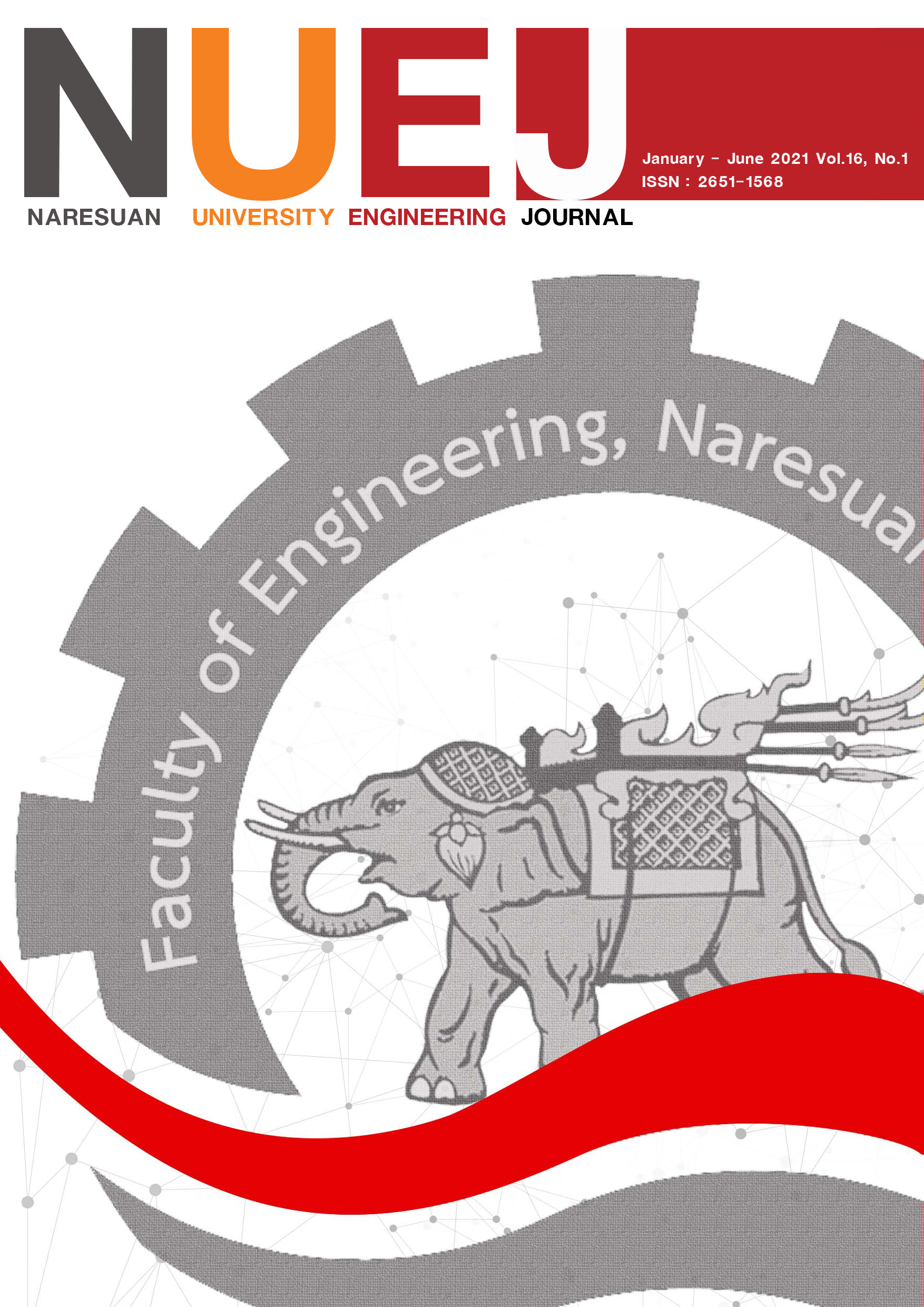การออกแบบผลิตภัณฑ์ด้วยวิธีการออกแบบเจเนอเรทีฟแบบหลายวัตถุประสงค์ กรณีศึกษาการออกแบบเครื่องประดับเข็มกลัดอาร์ตเดโคแบบกลัดคู่
Main Article Content
บทคัดย่อ
บทความนี้นำเสนอระบบออกแบบอัตโนมัติด้วยหลักการของเจเนอเรทีฟดีไซน์ ที่ช่วยค้นหาคำตอบที่เหมาะสมแบบหลายวัตถุประสงค์(Multi-objective Optimization Generative Design: MOOGD) เพื่อสร้างคำตอบของงานออกแบบที่แสดงผลลัพธ์ในลักษณะของโมเดลสามมิติที่มีความหลากหลายและเป็นจำนวนมากภายใต้วัตถุประสงค์ในการออกแบบที่มากกว่าหนึ่งวัตถุประสงค์ โดยเริ่มจากการสร้างโมเดลพาราเมตริกดีไซน์ของผลิตภัณฑ์ ซึ่งเป็นการสร้างโมเดลสามมิติของผลิตภัณฑ์ด้วยพารามิเตอร์ และควบคุมการเปลี่ยนแปลงรูปร่างของโมเดลสามมิติด้วยพารามิเตอร์ และพัฒนากระบวนการค้นหาคำตอบที่เหมาะสมแบบหลายวัตถุประสงค์ด้วยอัลกอริทึ่มวิวัฒนาการความแข็งแรงของพาเรโต 2 (Strength Pareto Evolutionary Algorithm II) ดังนั้นอัลกอริทึ่ม MOOGD ใช้วิธีค้นหาคำตอบที่อยู่บริเวณด้านหน้าของพาเรโต (Pareto-Optimal Front) โดยจะให้ชุดคำตอบที่มากกว่าหนึ่งคำตอบ ซึ่งชุดคำตอบเหล่านี้ จะถูกถอดรหัสโดยอัตโนมัติแปลงเป็นโมเดลสามมิติ นำเสนอต่อนักออกแบบบนโปรแกรมช่วยในการออกแบบ ดังนั้น MOOGD ทำหน้าที่เสมือนเป็นเครื่องมือช่วยในการตัดสินใจในกระบวนการออกแบบผลิตภัณฑ์ งานวิจัยนี้ได้นำเสนอตัวอย่างกรณีศึกษาการออกแบบเข็มกลัดสไตล์ยุคอาร์ตเดโค ที่สามารถแยกออกเป็นสองชิ้น (Art Deco Double Clip Brooch)โดยมีวัตถุประสงค์ในการออกแบบให้ได้น้ำหนักของเข็มกลัดที่น้อยที่สุด พร้อมกับมีสัดส่วนของเข็มกลัดใกล้เคียงกับอัตราส่วนทองมากที่สุด กรอบงานวิจัยนี้ สามารถนำไปพัฒนาประยุกต์ใช้กับการออกแบบผลิตภัณฑ์อื่นๆ ได้
Article Details
เอกสารอ้างอิง
Agarwal, M., & Cagan, J. (1998). A blend of different tastes: the language of coffeemakers. Environment and Planning B: Planning and Design, 25(2), 205-226.
Best, J. W. (1981). Research in education. Prentice-Hall.
Brintrup, A. M., Ramsden, J., & Tiwari, A. (2007). An interactive genetic algorithm-based framework for handling qualitative criteria in design optimization. Computers in Industry, 58(3), 279-291.
Brintrup, A. M., Ramsden, J., Takagi, H., & Tiwari, A. (2008). Ergonomic chair design by fusing qualitative and quantitative criteria using interactive genetic algorithms. IEEE Transactions on Evolutionary Computation, 12(3), 343-354.
Chuthavipa, W. (2002). Jewelry design. The Publisher of Chulalongkorn University.
Davidson, S. (2017). Grasshopper Algorithmic Modeling for Rhino. Grasshopper. http://www.grasshopper3d.com/
Deb, K. (2011). Multi-objective Optimisation Using Evolutionary Algorithms: An Introduction. Springer London.
Dou, R., Zong, C., & Nan, G. (2016). Multi-stage interactive genetic algorithm for collaborative product customization. Knowledge-Based Systems, 92, 43-54.
Hu, Z. H., Ding, Y. S., Zhang, W. B., & Yan, Q. (2008). An interactive co-evolutionary CAD system for garment pattern design. Computer-Aided Design, 40(12), 1094-1104.
Insuya, J., Laokafang, P., Jitkwang, P., Chomphooja, S. & Ratanamano, S. (2016). Adolescents and middle-aged. Human cmu. http://human.cmu.ac.th/home/hc/ebook/006305/07-teenage.pdf
Jongyoklang, S. (2012). Elements of jewelry design. Blogger. http://blackevil408.blogspot.com/p/blog-page_6677.html
Kang, B. (2014). Covetable Convertible - Art Deco Jewels. http://revivaljewels.com/blog/2014/7/8/ how-to-get-additional-wardrobe-mileage-from-your-jewellery
Kielarova, S. W., & Pradujphongphet, P. (2013). Development of generative jewelry design system using shape grammar method: a case study of jewelry ring design. Naresuan University Journal: Science and Technology, 8(2), 21-34.
Kielarova, S. W., & Sansri, S. (2016, December). Shape optimization in product design using interactive genetic algorithm integrated with multi-objective optimization. In International Workshop on Multi-disciplinary Trends in Artificial Intelligence (pp. 76-86). Springer.
Likert, R. (1961). New patterns of management. McGraw-Hill.
Lipson, H., & Shpitalni, M. (2000). Conceptual design and analysis by sketching. AI EDAM, 14(5), 391-401.
Lu, S., Mok, P. Y., & Jin, X. (2014). From design methodology to evolutionary design: An interactive creation of marble-like textile patterns. Engineering Applications of Artificial Intelligence, 32, 124-135.
Martinez, S. (2016). Dress Clips. Lang Antiques http://university.langantiques.com/index.php/Dress_Clips
McNeel, R. (2017). Rhinoceros. Rhinoceros. https://www.rhino3d.com/
Mouillefarine, L., & Posseme, E. (2009). Art deco jewelry: modernist masterworks and their makers. Thames & Hudson.
Nayutthaya, P. (2008). Design and analysis of experiments. Top Publishing.
Sansri, S. (2018). Development of generative jewelry design system with interactive evolutionary multi-objective optimization for art deco double clip brooch design (Unpublished master’s thesis). Naresuan University.
Sansri, S., & Kielarova, S. W. (2018). Multi-objective shape optimization in generative design: art deco double clip brooch jewelry design. In IT Convergence and Security 2017 (pp. 248-255). Springer, Singapore.
Séquin, C. H. (1997). Virtual prototyping of scherk-collins saddle rings. Leonardo, 30(2), 89-96.
Shibuya, M., Kita, H., & Kobayashi, S. (1999). Integration of multi-objective and interactive genetic algorithms and its application to animation design. 1999 IEEE International Conference on Systems, Man, and Cybernetics (pp. 646-651). IEEE.
Singh, V., & Gu, N. (2012). Towards an integrated generative design framework. Design studies, 33(2), 185-207.
Sinjaru, T. (2012). Research and statistical analysis with SPSS and AMOS. Business R & D Ordinary Partnership.
Soddu, C. (1994). GENERATIVE ART. http://www.soddu.it/design/GA_soddu_e.htm
Sun, X., Gong, D., & Zhang, W. (2012). Interactive genetic algorithms with large population and semi-supervised learning. Applied Soft Computing, 12(9), 3004-3013.
Takagi, H. (2001). Interactive evolutionary computation: Fusion of the capabilities of EC optimization and human evaluation. IEEE, 89(9), 1275-1296.
Takagi, H. (2001). Interactive evolutionary computation: Fusion of the capabilities of EC optimization and human evaluation. IEEE, 89(9), 1275-1296.
Tang, C. Y., Fung, K. Y., Lee, E. W., Ho, G. T., Siu, K. W., & Mou, W. L. (2013). Product form design using customer perception evaluation by a combined superellipse fitting and ANN approach. Advanced Engineering Informatics, 27(3), 386-394.
Vierlinger, R. (2017). Octopus. Octopus. http://www.food4rhino.com/app/octopus
Yamane, T. (1970). Statistics : An Introductory Analysis. Harper & Row.
Yotongyos, M. (2016). Questionnaire for research. KM_Research. www.bcn.ac.th/web/2007/KM_
Research/การสร้างแบบสอบถามเพื่อการวิจัย.pdf
Zhang, L., Zhang, L., & Wang, Y. (2016). Shape optimization of free-form buildings based on solar radiation gain and space efficiency using a multi-objective genetic algorithm in the severe cold zones of China. Solar Energy, 132, 38-50.
Zitzler, E., & Thiele, L. (1999). Multiobjective evolutionary algorithms: a comparative case study and the strength Pareto approach. IEEE transactions on Evolutionary Computation,
(4), 257-271.
Zitzler, E., Laumanns, M., & Thiele, L. (2001). SPEA2: Improving the strength Pareto evolutionary algorithm. TIK-report, 103.


